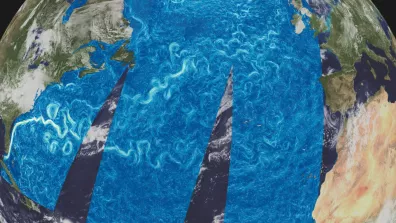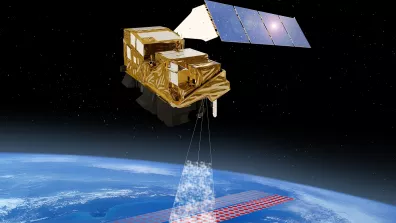NASA has announced the selection of the Ocean Dynamics and Surface Exchange with the Atmosphere mission (ODYSEA), for phase A of its new Earth System Explorers program. This program aims to develop the next generation of innovative scientific missions for Earth observation. The ODYSEA team will conduct a concept study over the next year.
A single instrument
The ODYSEA satellite would use a single instrument, a Doppler scatterometer built jointly by France and the United States. For the first time, it would thus be possible to measure ocean surface currents on a global scale, simultaneously with winds at the ocean surface.
These unprecedented measurements would enable daily monitoring of surface currents, which are still very poorly understood. Surface currents play an important role in transporting heat and carbon. Combined with surface winds, they help us to understand the exchanges between the atmosphere and the ocean.
They also carry plankton, algae and plastics, which is why studying them should open up a wide range of applications, including ecosystem and fisheries management, search and rescue at sea, monitoring of plastics and other marine pollutants, and research into renewable energies.
A new French-American project
This proposed international project, carried out jointly by CNES and NASA's Jet Propulsion Laboratory, would be the continuation of 30 years of cooperation in satellite altimetry through the TOPEX-Poseidon, Jason and, more recently, SWOT programs.
The possible mission is made up of an international American and French team, led by Dr Sarah Gille from the Scripps Institution of Oceanography on the American side and Dr Fabrice Ardhuin from the Laboratory for Ocean Physics and Satellite Remote Sensing (LOPS) on the French side.
Through the mission, CNES would work with a number of French scientific teams, laboratories and industrial companies (LOPS, LEGOS, IGE, MIO, IETR, DATLAS, ODL, CLS, TAS, etc.) over the next year.
Thanks to France's internationally recognised scientific and technical prowess in oceanography, a strong contribution to this possible mission would come from laboratories and manufacturers such as Thales Alenia Space Toulouse and Airbus Defence and Space.
Phase A of the mission has now started at CNES and is due to end in July 2025. The aim is to submit an interim dossier to NASA in February 2025. NASA has selected three other missions for conceptual studies and after the conclusion of these studies will down select to up to two missions for implementation.





